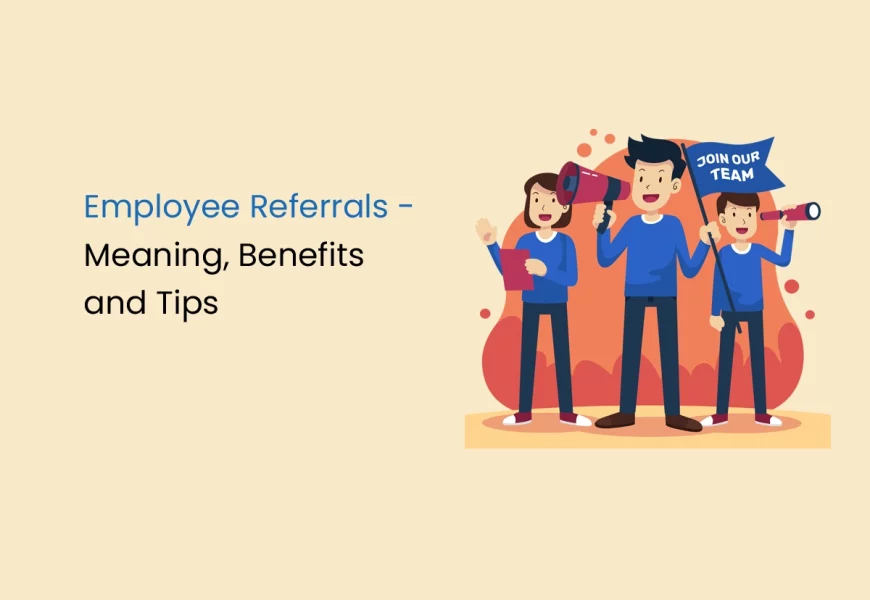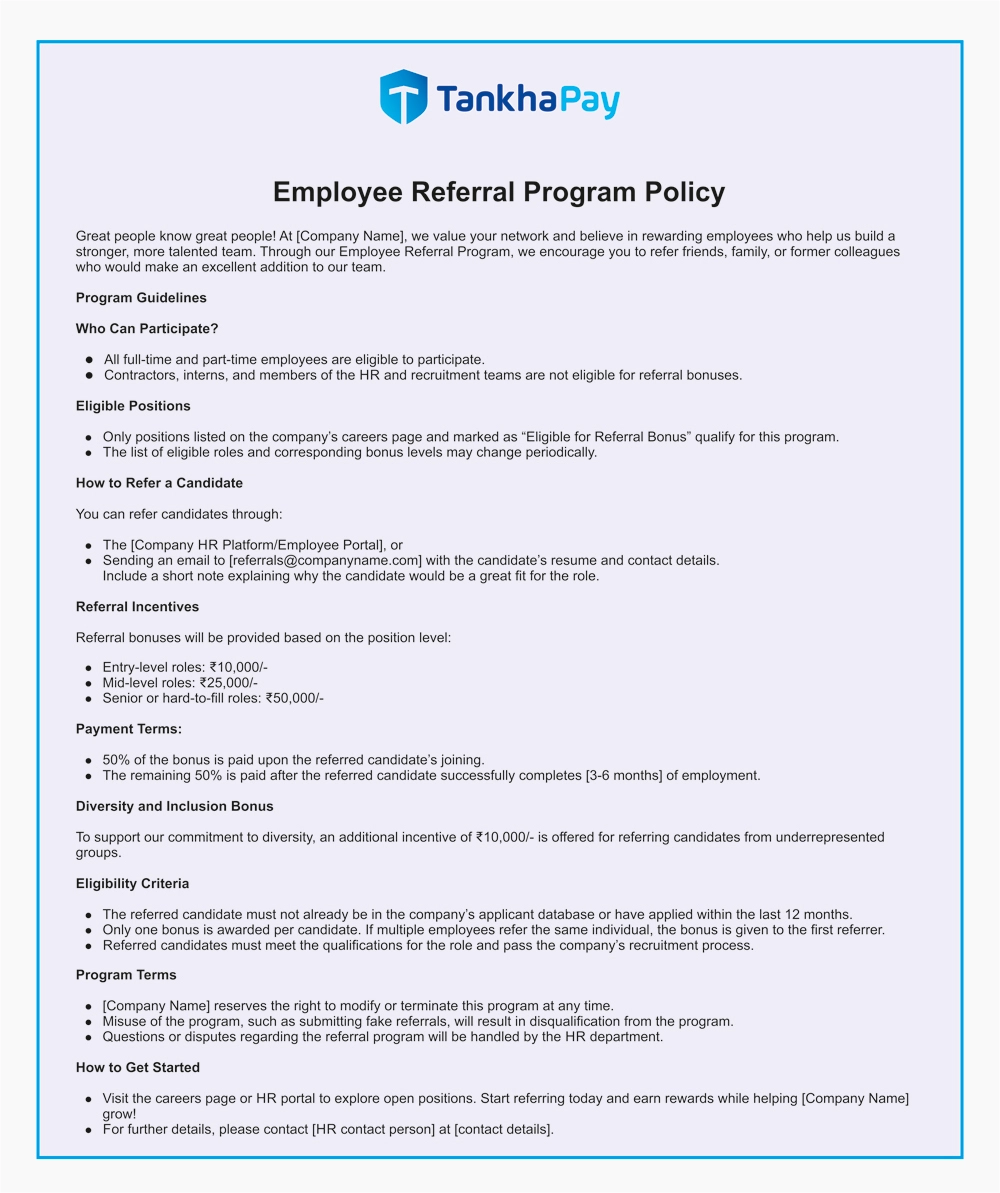The hiring landscape is becoming more competitive every day. Finding quality candidates who can respond to your company’s needs is becoming very difficult. An employee referral program uses the professional networks of current employees to source well-qualified candidates, making your recruitment process fruitful. This guide explores the meaning, benefits, and tips to encourage employee referrals.
If you want to build a collaborative company culture, employee referral programs are your way. Hiring an employee’s referral validates their judgement and makes them feel valued and involved in the company’s growth which boosts company morale. These channels pave the way to vet and hire genuine candidates.
What is an Employee Referral?
Employee referrals are a strong hiring process that allows employees to reach out to their personal and professional networks to source potential candidates for an open position. Bonus, extra vacation days, or even public recognition given to encourage the employees to refer friends or acquaintances who are a good fit for the job, also help the growth of the company. Such incentives lead not only to better job fitment but also result in higher retention rates and a more robust workforce.
Employee referrals are practical tools because they bring talented people to the workplace and build cohesion. Employees are often aware of the skills needed for a particular job, thus they are able to refer to candidates which are a good fit for the job role.
Essential Benefits of Employee Referrals
- Higher Quality Candidates: Typically, candidates coming through employee referrals have been a better fit for the role and culture. Employees in any situation understand the needs and expectations of the role and company, thus increasing the probability of successful hiring by referral, which leads to long-term results.This is contributed by the fact that employees know the job’s demands and the corporation’s principles. Therefore, their referrals are people whom they trust and regard professionally. When the firm recruits a candidate based on reference, it is more likely that the candidate possesses the required skills to execute the job role. Employee referrals thus add strength to team cohesiveness; this ultimately results in a stable work group.
- Cost saving: Employee referrals are not just about finding the right talent; they also bring significant cost savings. You can bypass job boards’ listing fees, agency costs, and other expenses associated with a prolonged interview process, companies can save thousands of rupees per hire. Employee referrals can save companies up to 40% for each hire. They eliminate the need for other advertising and recruitment costs, which make them a financially savvy choice for any organization. Employee referral programs often come with incentive systems and can thus usually be had at a significantly lower cost than traditional hiring. If you are hiring at a large scale, this can make all the difference for you.
- Faster Hiring Process: Employee referrals streamline the hiring process by allowing employees to pre-screen the candidates they refer. It has been found that referred candidates get hired 55% faster than those from other sources. The tremendous efficiency of this system not only reduces the cost per hire but also reduces the much-needed time-to-fill metric. Not only does it increase the ease of the candidate experience but also makes the hiring journey feel more personal and efficient. It increases the productivity of HR professionals manifold.
- Enhanced Employee Engagement: An employee referral program boosts engagement because it gets the employees involved in the hiring process. Employees will have a sense of ownership and attachment to the growth of the company since they will feel that they contributed to building the team.Regarding its overall workplace culture, having this morale boost has a positive effect. Staff thrives in such an environment where they feel their company’s growth is assured because they have contributed to its building.Hence, more engagement contributes to productivity.Employees who see their referrals valued are more inclined to take part in the program regularly. This strengthens their ties to the company’s objectives. All of these factors contribute to an overall higher rate of employee satisfaction, productivity and happiness.
- Ideal for Specialised Roles: Referrals are particularly beneficial for specialised or niche positions. Employees who are familiar with the industry and the specific skills needed are likely to know someone who fits the bill, which increases the chances of quickly filling these roles with the right talent. For example, technical and engineering positions, which often require specific skills and certifications, greatly benefit from referrals. Specialised roles can be especially tough to fill through traditional recruitment methods, as finding candidates with the necessary qualifications can be challenging.
Sample of Employee Referral Program Policy
Program Guidelines
Who Can Participate?
- All full-time and part-time employees are covered under the referral program.
- Contractors, interns, and HR and recruitment teams are exempt from the referral program.
Eligible Positions
- Only those roles that can be found on the company’s careers page and labeled “Eligible for Referral Bonus” are eligible to enter this referral program.
- Roles and bonus levels will change from time to time.
How to Submit Your Referrals
- Through the [Company HR Platform/Employee Portal], or
- E-mailing [referrals@companyname.com] with the resume and contact details of the candidate.
- A brief note explaining why you think that candidate will be great in that position.
Referral Incentives
Depending upon the position that a referred candidate is assuming a bonus shall be provided:
- Entry level: ₹ 10,000/-
- Mid-level: ₹ 25,000/
- Senior or hard-to-fill position: ₹ 50,000/-
- Rewards will be paid in two installments:
- 50% on joining day of the referred candidate.
- 50% on successful completion of [3-6 months].
Bonus Diversity and Inclusion Bonus
An additional incentive of ₹10,000 for referring the candidates from underrepresented groups has been added to support our commitment towards diversity.
Eligibility Criteria
- The referred candidate should not have an existing account in our applicant database or have applied in the last 12 months.
- One bonus will be paid per candidate. If several employees referred the same person, then the bonus goes to the one who submitted his/ her referral first.
- Candidates referred need to fit the described position and qualify by passing the recruitment process of the company.
Program Terms
- This policy shall be subject to change at the discretion of [Company Name].
- The referral program misuse, particularly fake submissions, makes a person ineligible to join the program.
- The HR department shall handle all inquiries or disputes of the program.
How to Get Started
- Browse available jobs on our careers page or HR portal. Make referrals today and support our growth with rewards!
- For more information, please don’t hesitate to get in touch with [HR contact person] at [contact details].
Download Employee Referral Policy Sample
How to Encourage Employee Referrals in Your Organisation
A successful employee referral program requires careful planning and effective communication. Here’s how to motivate employees to get involved:
Clearly Communicate Open Positions
Employees should be aware of the available roles and the skills needed. Descriptive job content, as well as sharing the opportunity on internal platforms, will help ensure the chance of employees referring applicants is maximised who are clearly suited for the role. Open communication keeps employees knowledgeable; thus, it enables them to make thoughtful referrals.
Emphasise Referral Benefits
Educate the employees on the cost-cutting benefits of referrals and what it does to the organisation. Bonuses, gift cards, or public recognition even among such employees will encourage more to talk good about your organisation and refer to good potential candidates.
Streamline the referral process
Create a friendly platform or internal application that makes it easy and uncomplicated for employees to easily refer people. The less complicated the process, the more employees will refer quality candidates. A system that is too burdensome or time-consuming may discourage employees from participating because this also negatively affects the program as a whole. In fact, more and more companies are now turning to dedicated referral platforms that make everything from submission to tracking the candidate’s progress really easy.
They can be encouraged to track the status of their referrals too; they appreciate being transparent about everything. Continuous referrals are fostered in keeping the system open, even if no positions are open at present. This ensures the company a steady pipeline of potentials who can be tapped into when a need for them arises so that candidates pre-vetted could be immediately approached. An open referral system allows employees to recommend good candidates with virtually no limits, thus contributing to a diversified and buoyant candidate pool
Acknowledge contributions
Never forget to appreciate the employees who have submitted referrals; it does not matter that the person submitted is not getting hired. From time to time, give them feedback and recognition-this goes a long way in keeping an employee actively engaged in the referral process. Efforts in referral are bound to be reinforced with recognition of value placed each contribution, regardless of the final hiring outcome.
Simple gestures such as sending thank-you emails or mentioning employees in team meetings can significantly impact. Companies can also organise quarterly or annual celebrations for top referrers to create a sense of achievement and healthy competition.
Keep the Program Open Year-Round
Having an open referral program even during times when there are no current openings available helps build a steady pipeline of potential hires. This way, when new slots are available, the company will have a pool of pre-vetted candidates they can screen from. Thus, it would be possible for an open referral system to allow employees to refer strong candidates without being held by any barrier, thereby translating into a diverse and robust candidate pool.
How to Design an Employee Referral Program
Step 1: Objectives and Key Metrics
Define before designing the program what you want to get:
Objectives:
- Decrease recruitment costs.
- Increase speed of hiring.
- Enhance employee engagement in hiring.
- Key metrics to measure
- The referral-to-hire ratio
- Retention rates of referred employees
- Diversity metrics for hires made through referrals
Step 2: Designing a Formed Program
Eligibility Criteria
- Specify who in the company can take part in the referral program, whether full-time or contract employees or interns.
- Define explicitly who can refer and whose bonus can be claimed, and maintain this list constantly updated.
- Submission Rules
- Employees should submit referrals through a user-friendly process such as:
- Online referral form.
- Dedicated email address.
- HR platform with the feature of referrals.
- Clarify what information is needed (name of candidate, contact details, resume, LinkedIn profile, etc.).
Reward Policy
- Cash Rewards:
- Tiered rewards according to the levels of positions:
- Pay rewards in phases (for example, after hiring, and after probationary period).
- Non-Cash Rewarding Ends
- More flexible discretionary time off, gift cards, gadgets, or experiences.
- Public acknowledgement – recognition in a newsletter, at a company meeting.
- Diversity and Inclusion Emphasis
Enhance bonus bonuses for referrals of under-represented groups as an encouragement to actualize diversity.
Step 3: Use Technology to Make it Simpler
- HR software or ATS can be used to:
- Streamline submission and tracking
- Notify employee on changes in status
- Track program’s success rates and payout timelines.
- If your company uses a platform like TankhaPay, integrate referral tracking into the employee self-service app for ease of use.
Step 4: Promote the Program Internally
Initial Launch:
- Announce the program through emails, team meetings, posters, and internal chat platforms (e.g., Slack or Microsoft Teams).
- Ongoing Communication:
- Regularly update employees on eligible positions, successful hires, and rewards.
- Use gamification (e.g., leaderboards or contests) to keep engagement high.
Step 5: Train Employees
- Involve employees with training sessions or webinars on how the program will operate.
- Provide some examples of ideal referrals for understanding of the type of candidate the organisation is looking for.
Step 6: Monitoring and Evaluating the Program
- Monitor metrics such as:
- Time-to-hire of referred candidates.
- Retention and performance of referred employees.
- Program ROI: Cost of rewards vs. savings on recruitment costs.
- Refine and improve the program from employee feedback.
Example of a Program Workflow
- Step 1: The employee submits the referral through the HR platform.
- Step 2: The HR team analyses the referral and begins interviewing
- Step 3: The status of the referral automatically gets updated to the employee
- Step 4: In case of a hire, the employee receives the reward in two parts:
- First half on the joining date of the candidate
- After completion of the probationary period.
Best Practices for HR to Create an Employee Referral Policy
Quick hiring, lower recruitment costs, and better fit for culture are some of the benefits offered by employee referrals. On the other hand, there is an overreliance on internal networks that may limit diversity. Here’s how best HR can design and manage a strong referral program that brings consistent and inclusive results :
Develop a Transparent Employee Referral Policy
Creating a well-structured referral policy is necessary for the program’s success. A structured mechanism allows HR teams as well as employees to know about the standards, expectations, and reward system that the program upholds. The clearer participants understand how to engage with the process, the more predictable and measurable the outcome will be.
Use Technology to Streamline Operations
Although the program relies heavily on employee networks, recruiting automation can improve workflow efficiency. For instance, some applicant tracking systems or some specific HR tools help manage applications, track referrals, and automate communication with the HR. Steps in this process can be automated for more time-saving results and increasing transparency for all parties involved.
Provide Training to Enhance Participation
Employees need to be apprised of the reason behind the program and best practices. Periodic workshops, webinars, and/or information sessions can:
- Explain how referrals help the company.
- Describe those characteristics and skills that HR is looking for in the candidates.
- Motivate employees to access various professional networks.
- Employees will engage more dynamically and quality of referrals will be of better grade if they comprehend the power of their referrals.
Diversity and Inclusion as a Top Priority
Diversity is the significant driving force behind innovation and long-term business success. Research finds that companies with diversified workforce outperform their less diverse peers up to 35% in terms of financial performance. To foster inclusion in the referral process:
Advocate for referrals from less represented groups.
- Pay an incentive similar to how Intel pays for diversity-driven referrals, double bonus cash for those targeted.
- Reinforce the value of diverse thinking when training and when presenting the program.
Continuously Monitor and Assess Outcomes
Since the program effectiveness will fade over time, its status and results need to be reviewed so that it can be sustained. Some metrics to measure will be the following:
- The ratio referred to hires.
- Retention rates of referred employees.
- Time-to-fill and cost-per-hire for referrals.
- Contributions of the program towards improving workplace diversity.
Applying these learnings, the program can then be further refined, rewards improved, and gaps in the program filled. The feedback from employees can also give perspectives toward improvement.
Conclusion
Employee referrals are a win-win strategy for both employers and employees. These programs also promote employee engagement and help build a cohesive and dedicated team. However, for referral programs to truly succeed, companies must communicate opportunities clearly, streamline the process, and offer compelling incentives.
If you want to avoid the hassle of managing employee referrals, payroll, and other HR processes, TankhaPay is here to simplify it for you. You can manage your referrals, compensation, and all HR-related tasks seamlessly. Start today and let us take care of the complexities, so you can focus on building your dream team with TankhaPay
FAQs on Employee Referrals
How do employee referrals help a company?
Employee referrals likely result in higher-quality hires, reduced recruitment costs and timescales, and morale among staff who feel they are contributing to the growth of the company bound to rise.
What incentives best motivate employee referrals?
Cash bonuses, extra days of vacations, gift cards, or public recognition are some proven incentives. Some organisations offer unique experiences: lunch with executives or recognition before a company-wide meeting.
How should companies communicate open positions to encourage referrals?
Strong job descriptions, regular updates on emails, and through internal portals keep the employee in the loop about the various openings; hence the chances of getting quality referrals are higher.
How can companies simplify the referral process?
An internal referral platform or form would help streamline the process, making it very easy for employees to recommend strong candidates.
Do employee referrals always result in faster hiring?
Generally, yes. Because the employees screen the referred candidates, the hiring process is often faster. However, this would depend on the recruitment processes of the company and the requirements of the role.
How does a business measure the success of their employee referral program?
Companies can measure the effectiveness of employee referrals by tracking the number of referrals, referral-to-hire ratios, retention rates, and cost savings. Most ATS systems have referral tracking capabilities.
What are some common challenges of a referral program by employees?
Difficulties include balance in using an employee referral program: fairness, no nepotism, and diversity. Distributing fair use of an employee referral program and other recruitment methods to help create a diverse candidate pool is a good thing.
Are bonuses given by an employer to an employee in connection with an employee referral taxable?
Yes, referral bonuses are typically considered taxable income. Communicating tax implications to employees upfront is advisable.
Can referrals be used for remote positions?
Absolutely. Employee referrals are effective for remote, hybrid, and in-office roles, expanding the candidate pool regardless of location.














